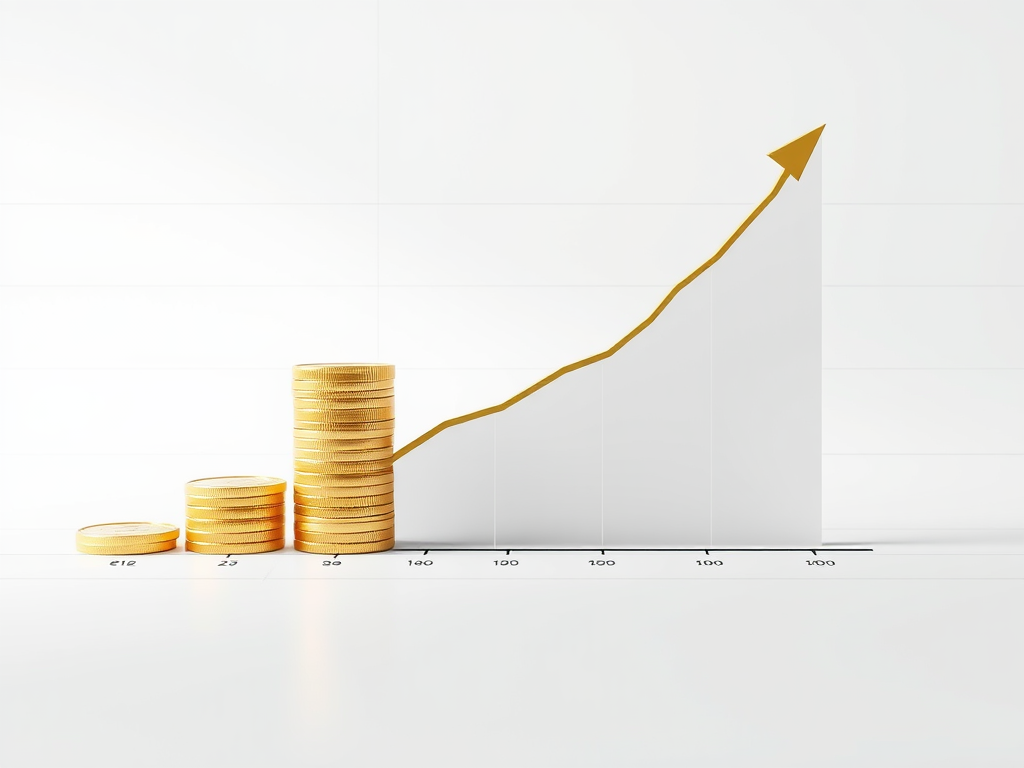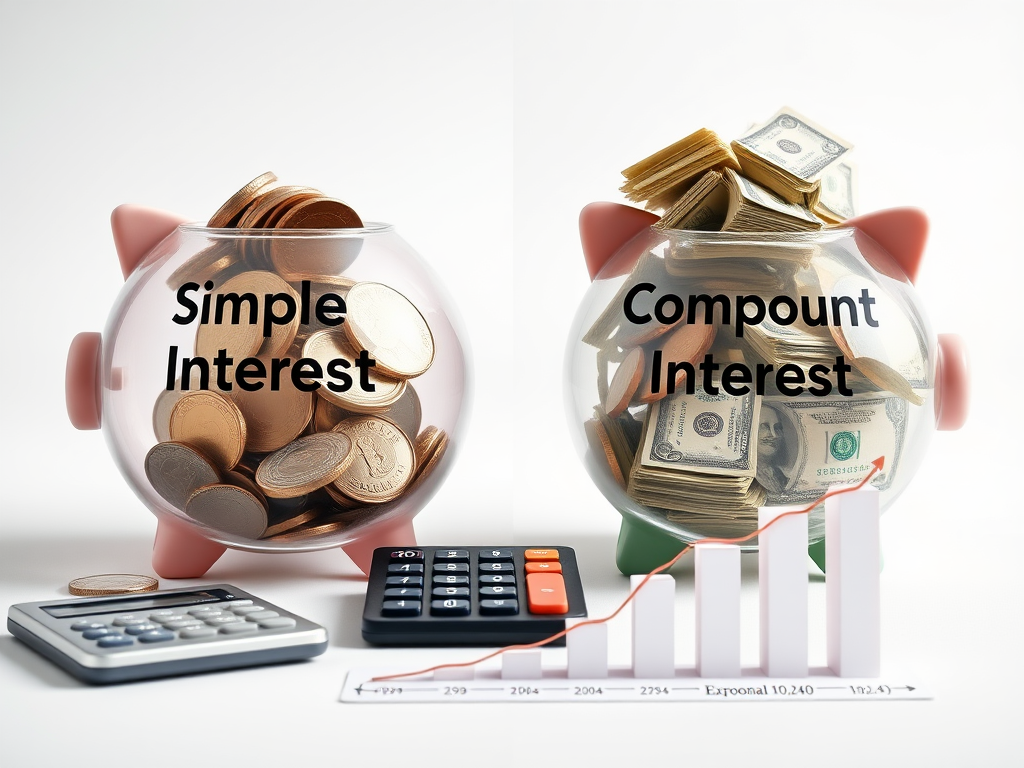💰 Have you ever wished for a magical formula to grow your wealth effortlessly? What if we told you that such a financial superpower exists, and it’s been hiding in plain sight all along? Enter the world of compound interest – the unsung hero of wealth creation that Albert Einstein reportedly called “the eighth wonder of the world.”
Imagine planting a money tree that not only grows but also produces seeds that grow into more money trees. That’s essentially what compound interest does for your finances. 🌳💰🌳 It’s the reason why some people seem to accumulate wealth at an astonishing rate while others struggle to make ends meet. But here’s the kicker: this financial marvel isn’t reserved for the elite. It’s a tool available to everyone, regardless of their current financial status.
In this blog post, we’ll demystify the power of compound interest and show you how to harness its potential. We’ll explore everything from its basic definition to its practical applications in investing, and even dive into the pros and cons. By the end, you’ll understand why starting early is crucial, who benefits the most from compound interest, and how to use online calculators to plan your financial future. Ready to unlock the secret to exponential wealth growth? Let’s dive in!
What Is Compound Interest?

Key Takeaways
Compound interest is a powerful financial concept that can significantly impact your wealth accumulation over time. Here are the key takeaways to understand:
-
Definition: Compound interest is the interest earned on both the principal amount and the accumulated interest from previous periods.
-
Exponential Growth: Unlike simple interest, compound interest leads to exponential growth of your investment or savings over time.
-
Time is Crucial: The longer you allow your money to compound, the greater the potential for growth.
-
Frequency Matters: More frequent compounding periods (e.g., daily vs. annually) result in faster growth.
Here’s a comparison of simple interest vs. compound interest:
| Aspect | Simple Interest | Compound Interest |
|---|---|---|
| Calculation | Only on principal | On principal and accumulated interest |
| Growth | Linear | Exponential |
| Time Impact | Less significant | Highly significant |
| Potential Returns | Lower | Higher |
Key factors affecting compound interest:
- Principal amount
- Interest rate
- Compounding frequency
- Time period
Understanding compound interest is essential for:
- Making informed investment decisions
- Planning long-term savings strategies
- Evaluating loan terms and credit card debt
By grasping these key takeaways, you’ll be better equipped to harness the power of compound interest in your financial journey. As we delve deeper into how compound interest works, you’ll gain a more comprehensive understanding of its mechanics and applications.
How Compound Interest Works

How Compound Interest Works
The Basic Formula
Compound interest is calculated using a specific formula:
A = P(1 + r/n)^(nt)
Where:
- A = Final amount
- P = Principal (initial investment)
- r = Annual interest rate (in decimal form)
- n = Number of times interest is compounded per year
- t = Number of years
This formula allows us to see how our money grows over time. Let’s break it down further:
Components of Compound Interest
- Principal: The initial amount invested or borrowed
- Interest rate: The percentage of the principal that’s added as interest
- Compounding frequency: How often the interest is calculated and added
- Time: The duration over which the interest compounds
Compounding Frequency
The frequency of compounding can significantly impact the growth of your investment:
| Compounding Frequency | Times per Year |
|---|---|
| Daily | 365 |
| Weekly | 52 |
| Monthly | 12 |
| Quarterly | 4 |
| Annually | 1 |
More frequent compounding leads to faster growth. This is why daily compounding is often preferred by savers and investors.
The Snowball Effect
Compound interest creates a “snowball effect” on your money:
- Initial investment earns interest
- Interest is added to the principal
- New total earns more interest
- Process repeats, accelerating growth
This effect becomes more powerful over time, which is why starting early with saving and investing is crucial for maximizing the benefits of compound interest.
The Power of Compound Interest

Tip
Compound interest is often referred to as “interest on interest,” and for good reason. It’s a powerful financial concept that can significantly boost your savings over time. To harness its full potential, remember this key tip: start early and be consistent. The earlier you begin saving or investing, the more time your money has to grow exponentially.
| Years of Saving | Initial Investment | Monthly Contribution | Interest Rate | Final Balance |
|---|---|---|---|---|
| 10 | $1,000 | $100 | 7% | $17,308 |
| 20 | $1,000 | $100 | 7% | $52,093 |
| 30 | $1,000 | $100 | 7% | $122,709 |
As the table shows, the power of compound interest becomes more evident over longer periods. Even small, regular contributions can lead to substantial wealth accumulation.
Compounding Interest Periods
The frequency of compounding plays a crucial role in the growth of your investment. Common compounding periods include:
- Daily
- Weekly
- Monthly
- Quarterly
- Semi-annually
- Annually
Generally, the more frequent the compounding, the faster your money grows. However, the difference becomes less significant over very long periods.
Compounding Period Frequency
The impact of compounding frequency can be substantial, especially for larger sums and longer investment horizons. Here’s how different compounding frequencies can affect your returns:
- Annual compounding: Interest is calculated once per year
- Semi-annual compounding: Interest is calculated twice per year
- Quarterly compounding: Interest is calculated four times per year
- Monthly compounding: Interest is calculated twelve times per year
- Daily compounding: Interest is calculated every day
While daily compounding might seem ideal, the difference between monthly and daily compounding is often negligible for most personal finance scenarios. The key is to focus on consistent saving and investing rather than obsessing over compounding frequency.
Now that we understand the power of compound interest, let’s explore why starting to save early is crucial for maximizing its benefits.
Compound Interest: Start Saving Early

The Importance of Starting Early
Starting your savings journey early can significantly amplify the power of compound interest. Let’s explore why time is your most valuable asset when it comes to growing your wealth.
The Time Advantage
Time is the secret ingredient that supercharges compound interest. The longer your money has to grow, the more dramatic the results. Consider this comparison:
| Scenario | Initial Investment | Monthly Contribution | Years Invested | Annual Return | Final Balance |
|---|---|---|---|---|---|
| Early Start | $1,000 | $100 | 40 | 7% | $262,481 |
| Late Start | $1,000 | $100 | 20 | 7% | $52,397 |
As you can see, starting early can lead to a significantly larger nest egg, even with the same initial investment and monthly contributions.
The Snowball Effect
Compound interest creates a snowball effect on your savings:
- Initial investment grows
- Interest earned is reinvested
- New interest is earned on the reinvested amount
- The cycle continues, accelerating growth over time
The earlier you start, the more time this cycle has to repeat, potentially leading to exponential growth.
Overcoming Inflation
Starting early also helps you stay ahead of inflation. By harnessing the power of compound interest from a young age, your money has a better chance of outpacing the rising cost of living, ensuring your savings maintain their purchasing power over time.
Now that we understand the importance of starting early, let’s examine the pros and cons of compound interest to get a well-rounded view of this financial concept.
Pros and Cons Compound Interest

Advantages Explained
Compound interest offers several significant benefits that can supercharge your financial growth:
- Exponential Growth: Unlike simple interest, compound interest allows your money to grow exponentially over time.
- Passive Income: Once set up, compound interest works automatically, requiring no additional effort.
- Time Amplification: The longer you invest, the more powerful the effect of compound interest becomes.
Here’s a comparison of compound interest vs. simple interest growth over time:
| Year | Initial Investment | Compound Interest (5% annually) | Simple Interest (5% annually) |
|---|---|---|---|
| 1 | $10,000 | $10,500 | $10,500 |
| 5 | $10,000 | $12,763 | $12,500 |
| 10 | $10,000 | $16,289 | $15,000 |
| 20 | $10,000 | $26,533 | $20,000 |
Disadvantages Explained
While compound interest can be a powerful tool for wealth creation, it’s important to consider its potential drawbacks:
- Debt Acceleration: When applied to loans, compound interest can cause debts to grow rapidly.
- Inflation Impact: The real value of your returns may be diminished by inflation over time.
- Tax Implications: In some cases, compound interest earnings may be subject to taxation, reducing overall gains.
Now that we’ve explored the pros and cons of compound interest, let’s look at how it applies specifically to investing strategies.
Compound Interest in Investing

Compound Interest in Investing
Compound interest plays a crucial role in investing, offering potential for significant wealth accumulation over time. Let’s explore how it applies to various investment vehicles and strategies.
Investment Vehicles Benefiting from Compound Interest
- Stocks and Mutual Funds
- Bonds
- High-Yield Savings Accounts
- Certificates of Deposit (CDs)
- Real Estate Investment Trusts (REITs)
Compound Interest Strategies in Investing
- Dividend Reinvestment: Automatically reinvesting dividends can accelerate compound growth.
- Dollar-Cost Averaging: Regular investments over time can take advantage of market fluctuations.
- Long-Term Holding: Allowing investments to compound over extended periods maximizes returns.
Comparison of Compound Interest Effects
| Investment Type | Initial Investment | Annual Return | Value After 30 Years |
|---|---|---|---|
| Stocks | $10,000 | 8% | $100,627 |
| Bonds | $10,000 | 4% | $32,434 |
| Savings Account | $10,000 | 1% | $13,478 |
The power of compound interest becomes evident when comparing long-term returns across different investment types. Stocks, with their higher potential returns, demonstrate the most dramatic growth over time.
To maximize the benefits of compound interest in investing, consider diversifying your portfolio, reinvesting dividends and interest, and maintaining a long-term perspective. Remember, the earlier you start investing, the more time your money has to grow through the magic of compound interest.
Tools for Calculating Compound Interest

Approach One: Multiplication
When calculating compound interest, the multiplication method is straightforward and intuitive. Here’s how it works:
- Start with your principal amount
- Multiply by (1 + interest rate) for each compounding period
For example, if you invest $1000 at 5% annual interest compounded yearly for 3 years:
Year 1: $1000 * 1.05 = $1050
Year 2: $1050 * 1.05 = $1102.50
Year 3: $1102.50 * 1.05 = $1157.63
This method is easy to understand but can be time-consuming for longer periods.
Approach Two: Fixed Formula
For a more efficient calculation, especially over longer periods, use this fixed formula:
A = P(1 + r)^n
Where:
- A = Final amount
- P = Principal amount
- r = Annual interest rate (as a decimal)
- n = Number of years
Using our previous example:
A = 1000(1 + 0.05)^3 = $1157.63
This formula quickly gives you the final amount without calculating each year individually.
Approach Three: Macro Function
For those using spreadsheet software like Excel or Google Sheets, macro functions offer a powerful tool for compound interest calculations. The most common function is:
=FV(rate, nper, pmt, [pv], [type])
| Parameter | Description |
|---|---|
| rate | Interest rate per period |
| nper | Total number of payment periods |
| pmt | Payment made each period |
| pv | Present value (optional) |
| type | When payments are due (optional) |
This function allows for more complex scenarios, including regular contributions or withdrawals, making it ideal for retirement planning or loan calculations.
Now that we’ve explored these calculation tools, let’s examine some popular online calculators that can simplify the process even further.
Online Calculators for Compound Interest

Popular Online Compound Interest Calculators
Features and Benefits
Online compound interest calculators offer a user-friendly way to visualize the growth of your investments over time. Here’s a comparison of some popular calculators:
| Calculator | Key Features | Unique Benefit |
|---|---|---|
| Investor.gov | Simple interface, adjustable compounding frequency | Official U.S. government tool |
| Bankrate | Multiple calculation modes, graphical results | Comprehensive financial information |
| NerdWallet | Easy-to-use sliders, savings goal setting | Personalized investment recommendations |
| Calculator.net | Detailed input options, printable results | Wide variety of financial calculators |
How to Use Online Calculators Effectively
-
Input accurate information:
- Initial investment amount
- Expected annual rate of return
- Investment duration
- Regular contribution amount (if any)
- Compounding frequency
-
Experiment with different scenarios:
- Adjust contribution amounts
- Vary investment durations
- Compare different rates of return
-
Analyze the results:
- Total amount after compounding
- Interest earned vs. principal invested
- Impact of different variables on final outcomes
Using these calculators can help you make informed decisions about your savings and investment strategies. They provide a clear picture of how compound interest can significantly boost your wealth over time. Next, we’ll explore how to determine if the interest on your investments or loans is being compounded.
How Can I Tell if Interest Is Compounded?

Identifying Compounded Interest
To determine if interest is compounded, look for specific indicators in your financial documents or account statements:
- Terminology: Check for phrases like “compounded daily,” “compounded monthly,” or “APY” (Annual Percentage Yield).
- Frequency: Look for mentions of how often interest is calculated (e.g., daily, monthly, quarterly, annually).
- Account type: Certain accounts typically use compound interest:
- Savings accounts
- Certificates of Deposit (CDs)
- Some investment accounts
Compound vs. Simple Interest
Understanding the difference between compound and simple interest can help you identify which one applies to your account:
| Feature | Compound Interest | Simple Interest |
|---|---|---|
| Calculation | Interest on principal and previously earned interest | Interest on principal only |
| Growth | Exponential | Linear |
| Typical use | Savings accounts, investments | Short-term loans, bonds |
Asking Your Financial Institution
If you’re still unsure, don’t hesitate to contact your bank or financial institution. They can provide detailed information about:
- Interest calculation method
- Compounding frequency
- Effective annual yield
By understanding how to identify compound interest, you can make more informed decisions about your savings and investments, maximizing the power of compound interest to grow your wealth over time.
What Is a Simple Definition of Compound Interest?

Simple Definition of Compound Interest
Compound interest is often described as “interest on interest.” It’s the process where the interest earned on an initial investment is reinvested, allowing you to earn additional interest on your growing balance. This creates a snowball effect, accelerating the growth of your money over time.
Key Components of Compound Interest
To better understand compound interest, let’s break it down into its essential elements:
- Principal: The initial amount invested or borrowed
- Interest rate: The percentage charged or earned on the principal
- Compounding frequency: How often interest is calculated and added to the principal
- Time: The duration over which compounding occurs
Compound Interest vs. Simple Interest
Here’s a comparison of compound interest and simple interest:
| Aspect | Compound Interest | Simple Interest |
|---|---|---|
| Calculation | Interest earned on principal and previously earned interest | Interest earned only on the principal |
| Growth | Exponential | Linear |
| Effect over time | More pronounced | Less significant |
| Typical use | Savings accounts, investments | Short-term loans |
Real-World Examples
- Savings accounts: Banks typically offer compound interest on deposits
- Investments: Stock market returns often compound over time
- Credit card debt: Unfortunately, compound interest can work against you with unpaid balances
Understanding compound interest is crucial for making informed financial decisions. Whether you’re saving for retirement, investing in the stock market, or managing debt, the power of compound interest can significantly impact your financial future.
Who Benefits From Compound Interest?

Who Benefits From Compound Interest?
Compound interest benefits a wide range of individuals and entities, but some groups stand to gain more than others. Let’s explore who reaps the most rewards from this financial phenomenon:
Long-term Investors
Long-term investors are among the biggest beneficiaries of compound interest. Here’s why:
- Time is their ally: The longer the investment period, the more dramatic the effects of compounding
- Reinvestment of earnings: Dividends and interest payments can be reinvested, accelerating growth
- Reduced impact of market volatility: Short-term fluctuations matter less over extended periods
Savers and Retirement Planners
Compound interest is a powerful tool for those focused on saving and planning for retirement:
- Regular contributions: Consistent savings habits amplify the compounding effect
- Tax-advantaged accounts: 401(k)s and IRAs offer additional benefits alongside compounding
- Peace of mind: Compounding can help build a substantial nest egg over time
Young Adults
Starting early gives young adults a significant advantage:
| Age Started Saving | Monthly Contribution | Total at Age 65 (7% annual return) |
|---|---|---|
| 25 | $500 | $1,144,183 |
| 35 | $500 | $556,197 |
| 45 | $500 | $250,882 |
Financial Institutions
Banks and lenders also benefit from compound interest:
- Mortgage interest: Compounding works in their favor on long-term loans
- Credit card debt: High-interest rates compound frequently, increasing profits
Understanding who benefits from compound interest can help individuals make informed financial decisions and leverage this powerful concept to their advantage.
The Bottom Line

Key Takeaways
The power of compound interest is undeniable in wealth accumulation and financial growth. Here are the key points to remember:
- Early start advantage
- Consistency is crucial
- Higher interest rates amplify growth
- Time is your greatest ally
Long-Term Financial Impact
Compound interest can significantly impact your long-term financial health. Consider the following comparison:
| Scenario | Initial Investment | Monthly Contribution | Interest Rate | Years | Final Balance |
|---|---|---|---|---|---|
| Early Start | $1,000 | $100 | 7% | 40 | $262,481 |
| Late Start | $1,000 | $100 | 7% | 20 | $52,397 |
This table clearly illustrates the dramatic difference in outcomes based on the investment timeframe.
Action Steps
To harness the power of compound interest:
- Start saving and investing as early as possible
- Maximize contributions to interest-bearing accounts
- Seek opportunities with higher interest rates
- Reinvest earnings to accelerate growth
- Be patient and stay committed to your financial goals
Understanding and utilizing compound interest is a fundamental strategy for building wealth over time. By making informed decisions and leveraging this financial principle, you can set yourself up for a more secure financial future.

Compound interest is a powerful financial tool that can significantly impact your wealth accumulation over time. By reinvesting earned interest, your money grows exponentially, offering substantial benefits to those who start saving early. While it can work wonders for investments and savings, it’s crucial to be aware of its potential drawbacks, especially when it comes to debt.
Understanding and harnessing the power of compound interest is essential for effective financial planning. Whether you’re saving for retirement, building an emergency fund, or investing in the stock market, compound interest can be your ally. Utilize online calculators and tools to visualize its effects on your financial goals, and remember that time is your greatest asset when it comes to compound interest. Start saving and investing early, and let the magic of compounding work for you to secure a brighter financial future.




